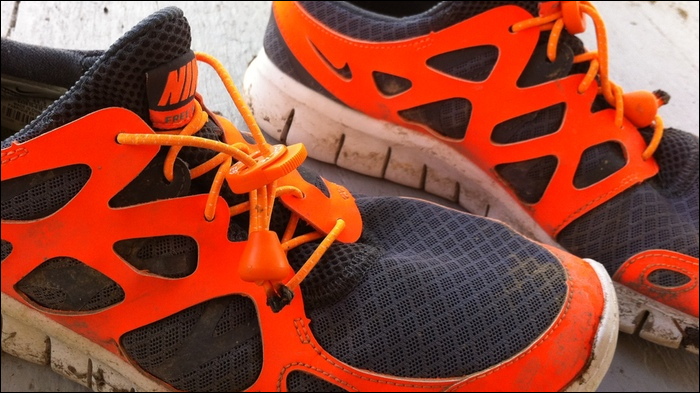Lock Laces
First, a caveat: What I like about running, as a sport, is that it’s such an elementary activity. There is very little expense or equipment required to get started. All you really need is any old pair of sneakers (if even that). Yammering on about particular kit is a favorite activity of enthusiasts of all kinds, but an interest in details should not be construed to mean they really matter, or that you must be equally familiar with them to be considered legit. Bear that in mind as you read on.
What I’m trying to say is, I’m about to tell you about my shoelaces.
You know the cliché about how long it takes some women to “get ready” to go out? That’s me, getting ready to go for a jog. Indecision about what to wear, or whether I need a hat. Another sip of water. And most of all, tying and re-tying my shoelaces. I’m like Goldilocks: it’s gotta be just right. Not too tight; not too loose. (I’m talking about the shoelaces now, not Goldilocks.)
So, I bought a set of Lock Laces on Amazon for like five bucks. The locks themselves are little spring-loaded plastic stocks for your shoelaces. Press the button to adjust the tension and release it to clamp the laces in place. The laces that come with Lock Laces are elastic, although I suspect they’d work fine with regular laces.
The point of all this is to make it easier, and quicker, to adjust the fit of your shoes. At this point some readers may wonder whether I am in fact even capable of knotting shoelaces in the regular fashion. I am! (And I remember the exact moment, kneeling before the living room stove, when I learned the knack of it.) But it’s nice to get the right fit without a lot of fiddling, and to be able to make adjustments while you’re on the go without pausing for more than a few seconds. That’s especially helpful in winter, when fingers may be too numb to knot laces with aplomb.
There are additional benefits similar to those yielded by the traditional double (or triple) knot: your laces don’t come untied, and the risk of having your foot broken by a shoelace caught in your bike’s chainring is greatly reduced. (Has that ever happened to you? It’s happened to me and it’s terribly frightening, as if an unseen hand had suddenly burst from the earth and gripped your ankle with the ferocious tenacity of the damned.)
“My shoes have stayed securely in place on my feet and my feet have been pretty comfortable. What more can you ask?” – tl;dr summary
Anyway, I have been running with these laces for the past week or two. So far, I like them. I can’t say they’ve really cut down on my “getting ready” time (distractions are easily substituted), but my shoes have stayed securely in place on my feet and my feet have been pretty comfortable. What more can you ask? I do think the elastic laces may count for more than I had originally thought, especially with a combination of flexible shoes and vigorous motion (they stay snug without feeling restrictive as the shape of the shoe changes).
All of the pleasing benefits I have enumerated here probably also apply to Velcro shoes. Sadly, there seems to be a near-total dearth of Velcro shoes marketed to the ambulatory adult crowd.
And yes, my running shoes are fluorescent orange. It helps low-flying planes avoid my wake.
Last but not least, for more more information about shoelaces and knots than you ever knew existed, go check out Ian’s Shoelace Lace.
Posted on Sunday, February 26th, 2012. Tags: running.
